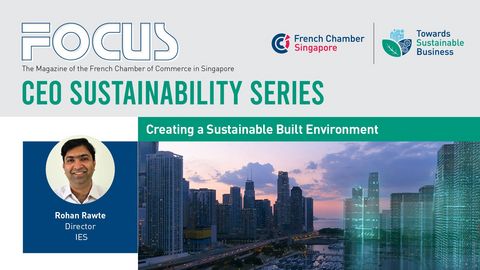Companies news • Analyses & Studies • Portraits • Publications
CEO Sustainability Series |Rohan Rawte, Director, IES

As part of the Sustainable Business initiative, the French Chamber of Commerce in Singapore presents a leadership interview series where we invite CEOs and key executives to discuss crucial management qualities that drive successful sustainable transformation
Question 1 : What does sustainability mean to IES?
At IES, sustainability is at the heart of everything we do. Our focus is the decarbonisation of the built environment, an area which accounts for almost 40% of global CO2 emissions and therefore has a crucial role to play in ensuring global climate targets are achieved.
We have dedicated almost three decades to improving the energy and carbon performance of buildings around the world through the application of our best-in-class building performance simulation technology and associated consultancy services. Our ultimate aim is to create a built environment that is resource and energy efficient; eliminating global reliance on fossil fuels while promoting comfort, health and wellbeing, and fairer access to energy for every citizen in the world.
Q2 : How might the use of digital technology reduce the environmental effect of cities and buildings?
Digital technology has a vital role to play in reducing the environmental impact of our buildings and cities. Our digital twin technology is used to create highly accurate virtual replicas of any building, or group of buildings, together with their associated energy networks, which are then used to simulate and make decisions on how to optimise the performance of the building(s) across their lifecycle.
This technology is invaluable when it comes to deciding the best way to design, build, operate and retrofit our buildings, or when selecting optimum decarbonisation options and renewable integrations. Users can simulate, analyse and compare different options – prior to investment/implementation in the real world - and see which will return the best outcomes across a range of metrics including energy, comfort, cost, occupant comfort and wellbeing. Once improvements are implemented to the real building(s), the digital twin can also be used to monitor building performance on an ongoing basis and ensure progress remains on track towards zero-carbon goals.
Our technology has been deployed on a multitude of sustainable building projects globally, with IES and our users conducting an estimated 75,000+ projects per year combined. A prime example would be our work with the Nanyang Technological University EcoCampus in Singapore, where our digital twin technology was used to identify 31% potential energy savings, S$4.7 million cost savings, and 9.6kt carbon savings across the campus.
Q3 : What are some of the biggest sustainability issues you’ve faced and how did you tackle all these sets of challenges?
Buildings are incredibly complex entities with shifting requirements that can change daily. Without appropriate tools and technologies that can help us understand exactly how they perform, it can be extremely challenging to know where to start with decarbonisation efforts.
IES recognised that our industry needed reliable, physics-based tools to accurately simulate, analyse, predict and monitor our buildings’ performance to inform better decisions around how to achieve decarbonisation in the most effective, efficient way. That’s why we developed our ICL Digital Twin technology suite, which leverages a unique combination of physics-enabled simulation, real data, machine learning and artificial intelligence to provide unparalleled insights across the lifecycle of any building, campus, community, city or portfolio. Enabling better decisions towards a zero-carbon built environment

This interview was conducted with Rohan Rawte Director IES
April 2023| French Chamber of Commerce in Singapore


